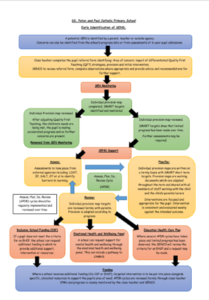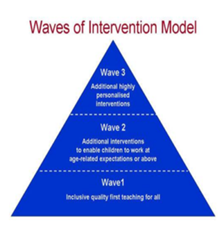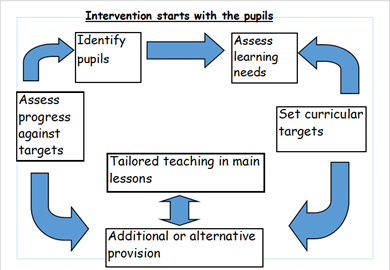Identification of SEND and the Graduated Response
At St. Luke’s Catholic Primary School, we recognise the importance of early identification of special educational needs and/or disability. It is pivotal that additional needs are identified at the earliest stage and effective provision is put into place to ensure successful long-term outcomes for the child. As a school, we follow our own school ‘Early Identification Flowchart’ which highlights the stages of our continuous SEN provision. We encourage parents to be part of this journey and to work in partnership with us as a school.


Early Identification of SEND – Flowchart – St. Luke’s
What is a ‘Graduated Response and how do we support your child with SEND in our school?
In accordance with the SEND Code of Practice 2015, we use a graduated response to identify and determine the support each individual child requires. We adopt a three-tiered approach to classify special educational needs which are different from everyday classroom provision.

Wave 1 is good quality, inclusive teaching which takes into account the learning needs of all the children in the classroom. This includes providing differentiated work and creating an inclusive learning environment.
Wave 2 outlines specific, additional and time-limited interventions provided for some children who are falling behind the age expected level. Wave 2 interventions are often targeted at a group of pupils with similar needs.
Wave 3 is targeted provision for a small percentage of children who either require a high level of additional support/specialised provision in order to address their needs or is for children who have been identified for an intervention designed to accelerate learning. We believe that all pupils learn best within their age-appropriate classroom environment alongside their peers. We encourage pupils to work independently where possible and are provided with the scaffolding and provision appropriate for their identified needs.
As a school, we provide additional intervention alongside daily class teaching. When considering interventions, we look at the child’s profile of learning and will match an intervention which aims to close the attainment gap between themselves and their peers. Interventions take place, where possible, within the classroom environment and do not take the place of other curriculum subjects.
If my child is working at Wave 2 or Wave 3, how to do ensure that the provision in place is correct and is having an impact?
SEN Code of Practice 6.7 explains that: ‘High quality teaching, differentiated for individual pupils, is the first step in responding to pupils who have or may have SEN.’ Where pupils are deemed to not be meeting age related expectation the assess, plan, do, review process will be implemented in consultation with parents.

We use the Assess, Plan, Do, Review model to continuously review provision and impact and to ensure that the child is making progress across all areas of their identified need.
We work in conjunction with pupils, parents and external agencies (when appropriate), to evaluate our ways of working and adapt strategies, intervention and support to achieve the best possible outcome.
For further information about the Assess, Plan, Do, Review process, please refer to our SEN Information report 2022-2023 – this can be found on the under the SEND policies section.








